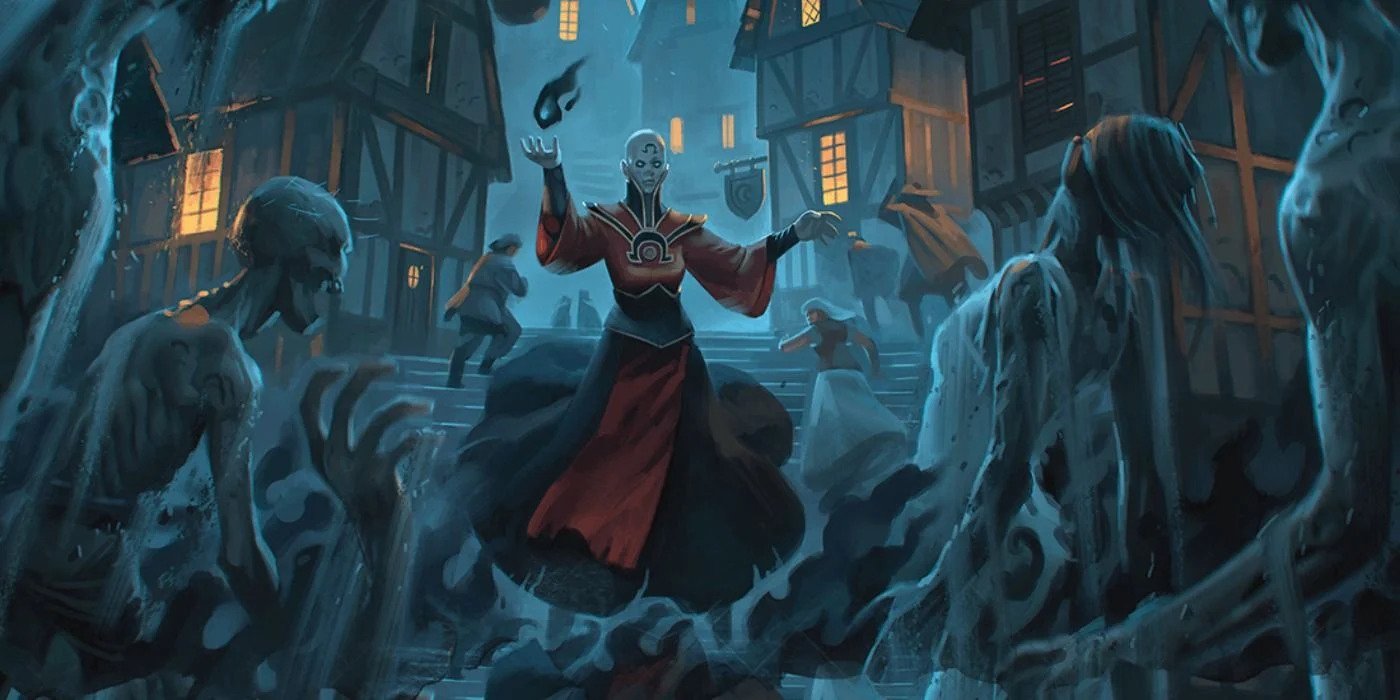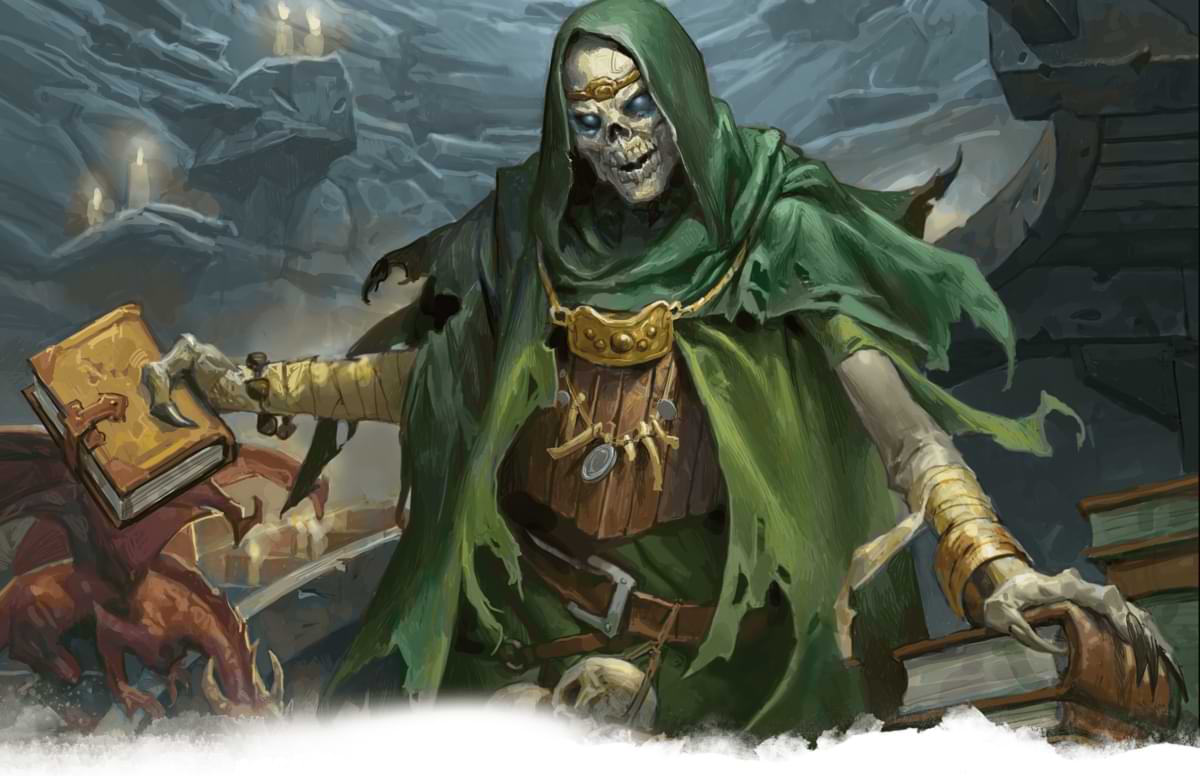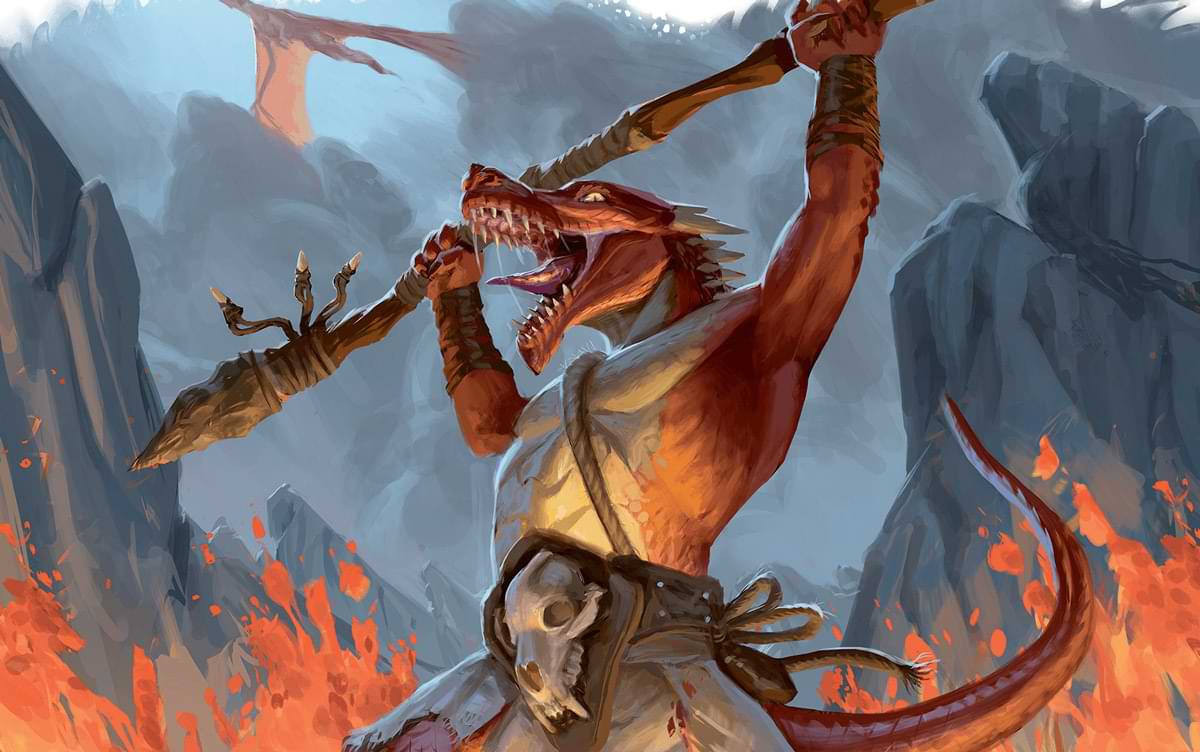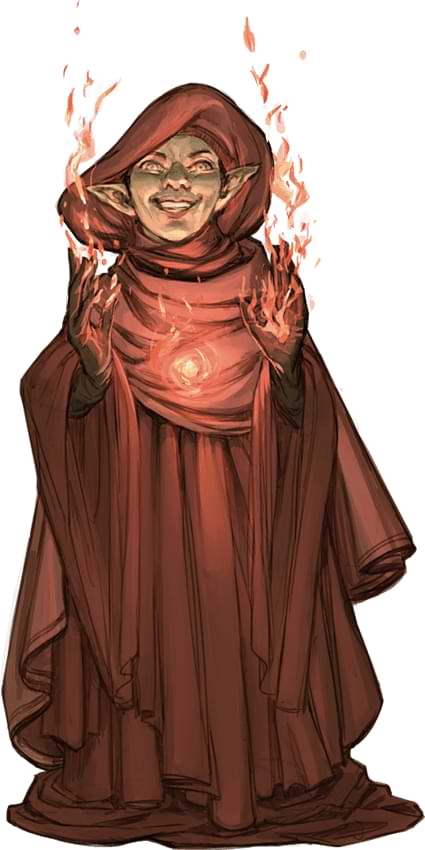Most of us are familiar with the character archetypes of hero and villain. The hero pulls off epic feats of bravery, selflessly pursuing justice for the greater good. The villain is the adversary, the obstacle to be overcome. They are often defined by selfishness, arrogance, and a complete disregard for the well-being of others. We may not want to play the squeaky-clean hero, but we also need to leave the outright villainy to the Big Bad. So, how can we create and play evil characters that can be played alongside heroic ones?
In this article, we will discuss ways to create and play an evil character that successfully skirts the line between hero and villain:
- How to create an evil character your friends will love
- The anti-hero archetype
- The anti-villain archetype
- Playing an evil character while respecting others
How to Create an Evil Character Your Friends Will Love

The most important aspect of creating an evil character is building common ground with the rest of the party. After all, a selfish character committing detestable deeds presents quite the problem for a party of do-gooders. If the characters have nothing in common, then why are they adventuring together? This is the most pressing issue many groups experience when someone plays an evil character, and why Dungeon Masters commonly ban them.
Evil characters are often created without a reason for being a member of an adventuring party. As a result, the other characters have no incentive for traveling alongside them. Without a shared goal, the good characters are likely to dump the troublemaker at their first chance because of the nuisance and danger they present to the group.
However, evil characters don’t have to rival the menace of the adventure's actual villain. There are two other archetypes available to us to base morally ambiguous characters on: the anti-hero, and the anti-villain.
Anti-Hero and Anti-Villain
The anti-hero is similar to the hero, but instead of selflessly fighting on the side of good, their motives are questionable, often based on self-interest. They do the right things, but for the wrong reasons. The anti-villain, on the other hand, is similar to a villain, but their evil actions are guided by more noble motives. They share the altruistic goal of heroes but can differ on the types of actions they are willing to take in order to reach it.
The anti-hero and anti-villain archetypes are useful reference points when building an evil character. They ride the line between hero and villain because they have a touchstone of common ground with good characters, either in their selfless motives or their moral actions.
The Anti-Hero Archetype: Doing the Right Thing for the Wrong Reasons

The anti-hero character often appears to be just another member of the party, their actions brave and good. Their motives, however, are another story entirely. A well-known example is the rogue who cares little about the lives they might save, because they are only in it for the money. They might delve into a dungeon, but where their fellow party members want to rescue villagers, the anti-hero just wants to get their hands on the powerful artifact held by their captors. Sure, they may do dangerous acts requiring stunning courage, but when push comes to shove, they won't go the extra mile unless it benefits their ulterior motive in some way. They do the right things, just for the wrong reasons.
To create an anti-hero, follow the these steps, considering what selfish motivation drives their otherwise good actions:
1. The Wrong Reasons: We begin by writing a compelling evil motive. As with the anti-villain, we can start with the ideals and bonds suggested in backgrounds, leaning toward evil and chaotic alignments. Greed and power as basic evil driving forces are common tropes that are easy to play out at the table. For a more complex motive and goal, the villainous scheme table in the Dungeon Master's Guide is an excellent resource. Perhaps they are driven by a fear of death and a need for immortality. Or they may be in the service of an evil deity, trying to fulfill a dangerous prophecy.
2. The Right Actions: Once we have a basic motive, we can flesh it out by listing neutral or good actions the character may take in pursuit of this goal. The important thing to keep in mind is ensuring commonality and a bond with the rest of the party members. Perhaps the character will brave the terrifying dungeon alongside everyone else but only do so in order to search for lost lore or powerful artifacts. Or they'll put their life at risk to save an NPC simply to gain access to their connections. For the anti-hero, they may put themselves in the line of fire for the sake of their own party members, but only because this group of people offers a chance at helping them succeed in their own goals.
The Anti-Villain Archetype: Doing Evil for the Greater Good
 The anti-villain character has honorable motives but is willing to push into questionable moral territory. Before you go off thinking your character can needlessly cleave through throngs of innocent townspeople, that isn't the character type we are talking about here. The anti-villain is driven by a high sense of morality, truly believing their actions are for the greater good. They don’t commit atrocities simply because it’s convenient, and most of the time, their actions align with those of the rest of the party. However, when there’s no other way to obtain their goal, the anti-villain is willing to get their hands a little more dirty than the others. When push comes to shove, the anti-villain may be willing to sacrifice an innocent life, claiming that the needs of the many outweigh the needs of the few.
The anti-villain character has honorable motives but is willing to push into questionable moral territory. Before you go off thinking your character can needlessly cleave through throngs of innocent townspeople, that isn't the character type we are talking about here. The anti-villain is driven by a high sense of morality, truly believing their actions are for the greater good. They don’t commit atrocities simply because it’s convenient, and most of the time, their actions align with those of the rest of the party. However, when there’s no other way to obtain their goal, the anti-villain is willing to get their hands a little more dirty than the others. When push comes to shove, the anti-villain may be willing to sacrifice an innocent life, claiming that the needs of the many outweigh the needs of the few.
To create an anti-villain, follow these steps, considering what "greater good" drives them to unethical actions:
1. The Right Reason: Creating an anti-villain starts with describing their good moral values: What exactly does this character want, and for what honorable reason? The good and lawful ideals and bonds suggested in backgrounds are an excellent place to start. Many of the chaotic and neutral ideals can serve as a good moral motivation when paired with a noble bond. For some extra oomph, look to pair your ideal and bond with a villainous scheme.
For example, a character that values freedom might pursue influence or power, doing whatever is necessary to regain their family’s noble title. They may pursue this goal so that they can help free others. Whatever greater good your character believes in, this driving force is the glue that connects the anti-villain to the rest of the party, so it needs to be specific and strong.
2. The Wrong Actions: Once we have a strong motive, we begin listing specific actions the character might take in order to achieve their goal. What ethical dilemmas are non-problems for them? What moral boundaries and lines might they cross? Just how far will they go in pursuit of their upright goal?
When playing this archetype as a player, it's important to remember that not only does the character need to have a reason for working alongside the group, the group must have a reason for working with the character. The anti-villain will agree with the vast majority of the actions and plans of the group. However, in select situations, they will be willing to diverge from the party’s generally good actions, and push farther into morally questionable territory.
Playing an Evil Character While Respecting Other Players
 An evil character traveling with a group of heroic do-gooders is going to cause tension within the party, especially in those situations when the character’s actions or desires conflict with that of the others. Not all conflict is bad, however.
An evil character traveling with a group of heroic do-gooders is going to cause tension within the party, especially in those situations when the character’s actions or desires conflict with that of the others. Not all conflict is bad, however.
The pattern of tension and resolution is the very thing that makes up so many different kinds of stories. "Can the heroes rescue the village from the pillaging bandits?" is a tension. When the village is saved, or has been plundered, that question is resolved. Evil characters present an opportunity for more of the campaign’s narrative tension to come from within the party dynamics: Will the party kill the bandits to save the village or simply seek to chase them off? Sometimes the story is less about bringing a villain to justice, and more about exploring what the concept of justice looks like from different perspectives.
Making Peace With Tension
Players should ensure that tension can and is being resolved, rather than playing a character that is so evil all the time that they are always in conflict with others. This is where the hard work done in our character building really shines, because we’ve defined the areas we have in common with the rest of the party and we have the information we need when negotiating in tense situations.
Our anti-villain draws on their pure motive and our anti-hero draws on their willingness to do the right things. It is the player’s responsibility to ensure their evil character is prepared to negotiate and compromise as needed, resolving the tension periodically and ultimately remaining a good member of the party.
It's What My Character Would Do
Evil characters must be played with deep care and with careful consideration for your fellow players. Playing a character that steals party gold, hoards all the magic items, or stabs another character in the back rarely makes a good play experience for everyone. Doing awful things in-game that ruin the fun for the rest of the group cannot be justified with the excuse of "It’s what my character would do." If a player expresses discomfort with a scene or a situation, don’t argue with them. Playing an evil character does not allow you to cross the lines of your fellow players.
Further, playing a character that often goes against the party is going to struggle to accomplish any of their goals. If your character seeks to be rich, pickpocketing your fellow adventurers is short-sighted and could lead them to lose future work as an adventurer. Instead, they could protect the party knowing full well that the more successful the group is on their quests, the more likely they'll snag higher-paying jobs.
Creating a Safe Space as the Dungeon Master
A safe roleplaying space doesn’t happen on its own. It has to be created with intention. A session zero is a great tool to establish boundaries as a group. You should revisit those boundaries periodically and utilize tools that make it easy for players to easily communicate if something goes too far. Be proactive, too. When there is a tense situation unfolding at the table, it’s a good idea to pause and ask if everyone is feeling okay with the conflict.
Separating the Friendly Player From Their Evil Character
It's important that all the players are on board with having an evil character within the party and are able to separate the tense relationship between the characters from the friendly relationships between the players. When the emotional state of the characters negatively affects those of the players out of the game, it is sometimes called "bleed." It is normal and healthy for players to have some sort of emotional reaction to the actions within the game, but when they go too far, tensions can erupt. Take a short break after particularly tense scenes, check in with everyone, and maybe have a laugh together. Sometimes, I will crack an out-of-game joke in the middle of a particularly tense scene. It’s a small thing that helps us separate the character’s stress from what we are feeling as players. Separating the characters from the players is the responsibility of everyone at the table.
Final Thoughts
Playing evil characters brings a different complexity to the game’s dynamics, but it doesn’t have to be problematic. Create an evil character who has deep ethical commonalities with the other characters, either by way of motivations or the actions they choose to take. Ensure your anti-hero or anti-villain has a good reason to be with the party, and vice versa. Maintain the group bonds by focusing on that commonality, utilizing it in times of tension. Always remember that being an evil character comes with the responsibility of remaining a good player.
Alyssa (@alyssavisscher) frequently rambles on Twitter about D&D. She especially enjoys analyzing its overall structure from a newbie perspective, bringing larger concepts to small, bite-sized pieces. She’s a parent of four, neurodivergent, disabled, and is impressively terrible at small talk.








-
View User Profile
-
Send Message
Posted Sep 21, 2022My first character is an evil barbarian with a background as a warrior. He gets along with the rest of the party because he know the value of soldiers working together, and general adventuring is giving him everything he wants: Money, fame, power and violence.
I do plan for him to soften up over time, and actually develop a genuine friendship with his party.
-
View User Profile
-
Send Message
Posted Sep 21, 2022hahaha - read this very quickly and thought "an evil librarian?" and then backed up ...
... who only reads the banned books, they're the ones where the "good stuff" is.
-
View User Profile
-
Send Message
Posted Sep 21, 2022Just a really great article, hands down!
-
View User Profile
-
Send Message
Posted Sep 21, 2022My favorite evil character I've played was a Dragonborn wizard/warlock. He was motivated by exactly 2 things: greed and cowardice. He would do anything to make himself richer or more powerful, but he was to cowardly to step out of line of the rest of the more traditionally heroic party. He stayed with the party at first to protect himself from a mob boss he stole from, and was forced to return as part of his parole. Undeniably a slimeball, definitely the most comical character I've played.
-
View User Profile
-
Send Message
Posted Sep 22, 2022Neato Article.
-
View User Profile
-
Send Message
Posted Sep 22, 2022evil wizard
motivated by banned books
-
View User Profile
-
Send Message
Posted Sep 23, 2022Great article. It helps reinforce why my favorite character ive played was an evil divination wizard. Giving them a valid reason to be useful to the party and for the party to be useful for them, because hey, a party serves as a good meat shield if nothing else.
I always found that the best way to peak at the evil side is thru the one on one interactions with NPCs. A great evil character shouldn't appear to be evil to their fellow party members.
-
View User Profile
-
Send Message
Posted Sep 23, 2022"Claiming that the needs of the many outweigh the needs of the few."
YES
Nerd genres unite!
-
View User Profile
-
Send Message
Posted Sep 23, 2022Back many years ago I ran a campaign where the entire group had gotten tired of playing the hero.. they all wanted to be villains who were working together aka society of evil… the evil cleric who pretended to be a good cleric, a thief that ran the town guild and an wizard who loved animating the dead.. the campaign didn’t last long but they seemed to enjoy me throwing various hero’s against them to thwart their plans. It got interesting when the townsfolk tried to run them out of town!
-
View User Profile
-
Send Message
Posted Sep 23, 2022Great article! Playing with morality and ethics is something try to do as a DM.
-
View User Profile
-
Send Message
Posted Sep 23, 2022Excellent article!
-
View User Profile
-
Send Message
Posted Sep 23, 2022Good explanations of evil player characters. It's fun to explore the nature of good and evil in game, and since 'everyone is the hero of his own story' it is easy for players to say their mostly evil character is neutral good. I would like more stuff on playing lawful good, there's countless ways to be evil but very few conflicts have a diffinitive 'good' side, even with fantasy 'evil races' involved. A lawful good cleric with passable wisdom would likely see everyone as evil, himself included.
-
View User Profile
-
Send Message
Posted Sep 23, 2022The article oversimplifies the concept of the antihero down to only one of its possible sub-archetypes. There's other ways you can write, or in this case play, an antihero.
In its broadest definition, an antihero is a hero who is significantly flawed in some way. They could be immoral or unethical in their actions, have less than pure motives, be a coward or a fool, suffer from anger issues or self-doubt, or have issues with social skills. Obviously not all of them would be evil on the alignment chart, but because this article is about evil characters I'll focus primarily on the ones that are.
First off, we have the ulterior motive types as you've mentioned. I actually feel like these are the most potentially dangerous evil-aligned player characters, because they're the easiest to turn against their party as their own wants and needs demand. You need either a group that's ok with party conflict or a campaign or character motive that doesn't give them a reason to turn. This also seems to be the most common type of evil player character, to the point where it's become THE go-to idea of an evil-aligned character.
The second type of evil-aligned antihero is the "token evil teammate". This character might technically be on the party's side in full, but they're not above doing the dirty work the rest of the party isn't willing to do. They could be the "bad cop" of the team, doing what's necessary to get results only because they've seen this situation before and they know being nice won't work. They may be extremely practical and not give a shit about things like morality and ethics. Or they could even enjoy the death, torture and bloodshed, but have no reason to oppose the party. This kind of evil character is pretty easy to play, but can come off as non-serious if care isn't taken and in worst case scenarios can result in "It's what my character would do" moments.
Finally, you have the rare "heroic" version of the "well intentioned extremist". You listed this type of character as the anti-villain archetype, however like with anti-heroes there's more types of anti-villains than just this. Like you've stated, the well intentioned extremist is someone who does the wrong things for the right reasons (or at the very least what they believe to be the right reasons). The "heroic" version of this character sub-archetype is simply this character taken from the character's point of view. Similar to the token-evil teammate, they're firmly on the party's side, however while the "token evil teammate" aligns themselves to the party's goals in a more casual way, the "heroic well-intentioned extremist" already has fundamentally shared interest with the party. There is the possibility of this character being disruptive - after all, party conflict can result from this character and the rest of the party disagreeing on how to do something - but it's easier to resolve when when the party still has a unified goal.
-
View User Profile
-
Send Message
Posted Sep 23, 2022Back in the 2ed AD&D days we played Hommlet backwards, with the entire party starting as low level ( mostly half-orc ) evil characters at the moathouse and raided the village of Hommlet at night for gear and loot. Didn't end well as there are a lot of higher level characters showing up once the town is awakened and the militia starts gathering but it was a lot of fun. And because we were all evil there was no real conflict.
-
View User Profile
-
Send Message
Posted Sep 23, 2022When you play an evil character it should be with people you know. Playing an evil character with a bunch of random people is never a good idea and will never be welcomed or end well. It's hard to hear but most people who do that want to be edge lords and enjoy ruining the game for random people, likely but not always because their normal group won't put up with it so they are banking on people who don't know them to let them get away with crappy behavior.
-
View User Profile
-
Send Message
Posted Sep 23, 2022Kind of unrelated, but I always wanted to see movies with good guys and bad guys re-made where the bad guys are presented as the good guys and vice versa. Sometimes, it's all a matter of perspective and presentation. Very few scenarios exist in black and white. I imagine that most people and fictional characters tend to think they are doing the right thing most of the time. Often in life, we are faced with only bad and worse choices.
-
View User Profile
-
Send Message
Posted Sep 23, 2022You can clearly be evil without robbing the other players of being "heroes". Stupid take.
-
View User Profile
-
Send Message
Posted Sep 24, 2022I just had session 0/1 with my party. Most of us are new to DnD. As DM, I told my players to act as their character would. The chaotic neutral Dragonborn Paladin beheaded the goblin they were interrogating before he could spill the information just cause. Maybe I overemphasized roleplaying...
-
View User Profile
-
Send Message
Posted Sep 24, 2022I made a character who is unabashidly evil. Not above murder, torture, manipulating, etc. One time he was on a quest for his evil deity and patron and upon the successful completion of said quest, accidentally saved a town in the process - it involved a necromancer who upset the deity my character is involved with, but who was also terrorizing the town with his undead.
This town showered him with praise, money and food. So he thought to himself that this is a pretty good way to live. Pretend to be a hero, do odd jobs, don't upset the townfolk by doing evil (at least not where he can be caught) and he has a place to stay, food to eat, and money to spend.
Oh, a group of travellers are on a quest to save the world? If saving a town rewards me like this, I wonder what kind of rewards I will get for saving the world...
-
View User Profile
-
Send Message
Posted Sep 24, 2022Evil can also masquerade as good, or not show their true motives. EEvil can be cunning, manipulative, and beautiful. Look at Emperor Palpatine. Imagine him as Senator Palpatine the Bard Diplomat in your party. Can everyone pull that off? No. Should DM's disallow them entirely? Well, that depends if the DM is capable of pulling it off too.